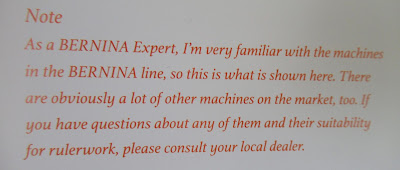Mary at ZippyQuilts invited me to be a guest on her blog! Even though I’ve been blogging for 11 years, this is the first time I’ve been invited to write a post for someone else's site. What I've written here also appears on her blog.
This post is to review a new book published by C&T: The Ultimate Guide to Rulerwork Quilting by Amanda Murphy.
Mary invited me to review the book knowing I'm an avid domestic machine quilter who began quilting in 2000, and started quilting with rulers in 2011.
Here's one of my first rulerwork attempts - doing a no-no by using a regular free motion quilting foot against a Fine Line brand quilting ruler.
 |
| Ruler work quilting with the WRONG machine foot! |
Two overall observations about the book:
- Because Amanda quilts on a Bernina (both a domestic machine and a longarm machine) the book focuses on how to rulerwork quilt on a Bernina. One page is devoted to: "What if you don't own a Bernina?"
- Pages 29 to 102 of the 127 pages have photos of rulers being used on a Bernina longarm.
 |
| from the book |
For me, currently using a Bernina 770QE for quilting, (I do not own a longarm), I was able to apply much of the information to my own Bernina experiences. She references using a stitch regulator, but those of us who quilt on a domestic machine with a stitch regulator, are unable to use the stitch regulator and a ruler work foot at the same time.
Interestingly, she mentions that rulerwork quilting is better for distributing quilting evenly across the surface because of being able to quilt in all directions.
 |
| from the book |
Amanda covers these important topics:
- thicknesses and shapes of rulers
- ruler work quilting table set-up
- sewing machine settings
- needles
I concur with these points covered in the book:
- Ruler thickness is important, and which thickness ruler to buy depends on whether your machine’s ruler foot is high shank or low shank
Each sewing machine brand needs its appropriate high shank or low shank ruler work foot.
- Buy a ruler you will use most often
 |
| from the book |
Just as a quiltmaker invests in one or two most-used rotary cutting rulers, a rulerwork quilter need only invest in one or two rulers. Begin rulerwork quilting with a straight edge and/or gentle curve ruler and you’re good to go - like the Good Measure straight edge/curved edge ruler (above left), or Westalee straight edge/curved edge ruler (shown below).
These are some of the brands of rulers I've accumulated in the past nine years, with Fine Line rulers being the ones I use most often... probably because that's the brand I started with. I don't own any Good Measure brand rulers.
A bit about Fine Line rulers... They're different - made with two vertical posts to "hang onto" when quilting (see first blog picture). However, after buying a sewing machine with the dual feed feature, I quickly learned that these ruler posts bump into the dual feed! I can't use the ruler on the back of the ruler foot, so that's something to keep in mind when considering a Fine Line brand ruler.
 |
| Fine Line ruler posts bump into dual feed mechanism |
Amanda mentions Bernina's echo clips, something I frequently use, though the brand I own is made by Westalee. Each slips on/off the ruler foot, and has different spacing, so you can choose how far away to quilt from the previous line of quilting. It's well worth $10 for the Westalee set!
- Set-up is important: have a flat work surface with a means for easy quilt gliding
Amanda recommends the Sew Steady table, and that’s exactly what I have. Top it with a Supreme Slider (or a Queen Supreme if you have a large machine harp), and you’re good.
Here's my quilting set-up contrived by placing two hollow-core doors across four IKEA adjustable-height Finnvard trestles.
Although I have my favorite methods for rulerwork quilting, I also learned a thing or two in the book. The tip that meant the most to me is this one...
 |
| from the book |









I had not bought the Westalee echo guides because I wasn't sure they would fit on a Bernina foot, so thanks for that info! Also, rubbing a dab of glycerin on your hands will make them grippy and not hurt the quilt. It feels a bit weird, though, so I usually use my gardening gloves instead. I like TrueGrips for making the rulers nonslip. I was afraid the skateboard grip wouldn't come off if I needed it to for some reason.
ReplyDeleteThanks! I just forwarded this to Lynn 🙂
ReplyDeleteI had no idea there are so many rulers for this type of quilting. I'll never use them since I send most of my quilts to a longarm quilting to insure they get finished, but it was interesting to learn something new.
ReplyDeleteVery good post with lots of information when considering what rulers to purchase for your machine type. Thanks.
ReplyDelete